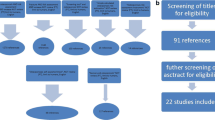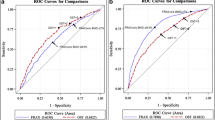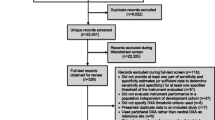Abstract
Summary
Clinical performance of osteoporosis risk assessment tools was studied in women aged 67 years and older. Weight was as accurate as two of the tools to detect low bone density. Discriminatory ability was slightly better for the OST risk tool, which is based only on age and weight.
Introduction
Screening performance of osteoporosis risk assessment tools has not been tested in a large, population-based US cohort.
Methods
We conducted a diagnostic accuracy analysis of the Osteoporosis Self-assessment Tool (OST), Osteoporosis Risk Assessment Instrument (ORAI), Simple Calculated Osteoporosis Risk Estimation (SCORE), and individual risk factors (age, weight or prior fracture) to identify low central (hip and lumbar spine) bone mineral density (BMD) in 7779 US women aged 67 years and older participating in the Study of Osteoporotic Fractures.
Results
The OST had the greatest area under the receiver operating characteristic curve (AUC 0.76, 95% CI 0.74, 0.77). Weight had an AUC of 0.73 (95% CI 0.72, 0.75), which was ≥AUC values for the ORAI, SCORE, age or prior fracture. Using cut points from the development papers, the risk tools had sensitivities ≥85% and specificities ≤48%. When new cut points were set to achieve a likelihood ratio of negative 0.1–0.2, the tools ruled out fewer than 1/4 of women without low central BMD.
Conclusions
Weight identified low central BMD as accurately as the ORAI and SCORE. The risk tools would be unlikely to show an advantage over simple weight cut points in an osteoporosis screening protocol for elderly women.

Similar content being viewed by others
References
Koh L, Ben Sedrine W, Torralba T, Kung A, Fujiwara S, Chan S, Huang Q, Rajatanavin R, Tsai K, Park H, Reginster J (2001) A simple tool to identify Asian women at increased risk of osteoporosis. Osteoporos Int 12:699–705
Cadarette S, Jaglal S, Kreiger N, McIsaac W, Darlington G, Tu J (2000) Development and validation of the Osteoporosis Risk Assessment Instrument to facilitate selection of women for bone densitometry. CMAJ 162:1289–1294
Lydick E, Cook K, Turpin J, Melton M, Stine R, Byrnes C (1998) Development and validation of a simple questionnaire to facilitate identification of women likely to have low bone density. Am J Man Care 4:37–48
Richy F, Gourlay M, Ross P, Sen S, Radican L, De Ceulaer F, Ben Sedrine W, Ethgen O, Bruyere O, Reginster J-Y (2004) Validation and comparative evaluation of the Osteoporosis Self-assessment Tool (OST) in a Caucasian population from Belgium. QJM 97:39–46
Ben Sedrine W, Devogelear JP, Kaufman J-M, Goemaere S, Depresseux G, Zegels B, Deroisy R, Reginster J-Y (2001) Evaluation of the Simple Calculated Osteoporosis Risk Estimation (SCORE) in a sample of white women from Belgium. Bone 29:374–380
Geusens P, Hochberg M, van der Voort D, Pols H, van der Klift M, Siris E, Melton M, Turpin J, Byrnes C, Ross P (2002) Performance of risk indices for identifying low bone density in postmenopausal women. Mayo Clin Proc 77:629–637
Cadarette S, Jaglal S, Murray T, McIsaac W, Joseph L, Brown J (2001) Evaluation of decision rules for referring women for bone densitometry by dual-energy x-ray absorptiometry. JAMA 286:57–63
Cadarette S, McIsaac W, Hawker GA, Jaakkimainen L, Culbert A, Zarifa G, Ola E, Jaglal S (2004) The validity of decision rules for selecting women with primary osteoporosis for bone mineral density testing. Osteoporos Int 15:361–366
Rud B, Jensen J, Mosekilde L, Nielsen S, Hilden J, Abrahamsen B (2005) Performance of four clinical screening tools to select peri- and early postmenopausal women for dual X-ray absorptiometry. Osteoporos Int 16:764–772
Gourlay M, Miller W, Richy F, Garrett J, Hanson L, Reginster J-Y (2005) Performance of osteoporosis risk assessment tools in postmenopausal women aged 45 to 64 years. Osteoporos Int 16:921–927
Mauck K, Cuddihy M-T, Atkinson E, Melton LJ, 3rd (2005) Use of clinical prediction rules in detecting osteoporosis in a population-based sample of postmenopausal women. Arch Intern Med 165:530–536
Cummings S, Black D, Nevitt M, Browner W, Cauley J, Genant H, Mascioli S, Scott J, Seeley D, Steiger P, Vogt T (1990) Appendicular bone density and age predict hip fracture in women. The Study of Osteoporotic Fractures Research Group. JAMA 263:665–668
World Health Organization. Assessment of osteoporotic fracture risk and its role in screening for postmenopausal osteoporosis. WHO Technical report series no. 843. Geneva: World Health Organization 1994
Looker A, Wahner H, Dunn W, Calvo M, Harris T, Heyse S, Johnston C Jr, Lindsay R (1998) Updated data on proximal femur bone mineral levels of US adults. Osteoporos Int 8:468–489
Hologic, Inc. Bone mineral density international normative data tables for men and women, report from manufacturer modified 11/4/91 and 2/1/97
Rud B, Hilden J, Hyldstrup L, Hrobjartsson A (2007) Performance of the Osteoporosis Self-Assessment Tool in ruling out low bone mineral density in postmenopausal women: a systematic review. Osteoporos Int 18:1177–1187
Dargent-Molina P, Poitiers F, Breart G (2002) In elderly women weight is the best predictor of a very low bone mineral density: evidence from the EPIDOS Study. Osteoporos Int 11:881–888
Kanis J, Johnell O, De Laet C, Johansson H, Oden A, Delmas P, Eisman J, Fujiwara S, Garnero P, Kroger H, McCloskey E, Mellstrom D, Melton LJ, 3rd, Pols H, Reeve J, Silman A, Tenenhouse A (2004) A meta-analysis of previous fracture and subsequent fracture risk. Bone 35:375–382
USPSTF (2002) Screening for osteoporosis in postmenopausal women: recommendations and rationale. Ann Intern Med 137:526–528
National Osteoporosis Foundation. Physician’s guide to prevention and treatment of osteoporosis. 1999, updated in 2003. http://www.nof.org/. Accessed November 10, 2007.
StataCorp. Confidence intervals for means, proportions, and counts. In: Stata Statistical Software: Release 9.0 User’s Guide, Volume 1. College Station, TX: Stata Corporation;2005
Deeks J, Altman D (2004) Diagnostic tests 4: likelihood ratios. BMJ 329:168–169
Jaeschke R, Guyatt G, Lijmer J (2002) Diagnostic tests. In: Guyatt G, Drummond R (eds) Users’ guides to the medical literature: a manual for evidence-based clinical practice. AMA Press, Chicago, pp 121–139
Simel D, Samsa G, Matchar D (1991) Likelihood ratios with confidence: sample size estimation from diagnostic test studies. J Clin Epidemiol 44:763–770
SAS Institute Inc (2004) SAS/STAT 9.1 User’s Guide. Cary, NC: SAS Institute Inc. In:
StataCorp (2005). Stata Statistical Software: Release SE 9.0. College Station, TX: Stata Corporation. In:
Fred Hutchinson Cancer Research Center, Department of Biostatistics, University of Washington. The statistical evaluation of medical tests for classification and prediction: datasets and Stata programs used in the text. http://www.fhcrc.org/science/labs/pepe/book/#progs, accessed November 10, 2007.
Nelson H, Helfand M, Woolf S, Allan J (2002) Screening for postmenopausal osteoporosis: a review of the evidence for the US Preventive Services Task Force. Ann Intern Med 137:529–541
Looker A, Johnston C Jr, Wahner H, Dunn W, Calvo M, Harris T, Heyse S, Lindsay R (1995) Prevalence of low femoral bone density in older US women from NHANES III. J Bone Miner Res 10:796–802
Richy F, Ethgen O, Bruyere O, Mawet A, Reginster J-Y (2004) Primary prevention of osteoporosis: mass screening scenario or prescreening with questionnaires? An economic perspective. J Bone Miner Res 19:1955–1960
Kanis J, Oden A, Johnell O, Johansson H, DeLaet C, Brown J, Burckhardt P, Cooper C, Christiansen C, Cummings S, Eisman J, Fujiwara S, Gluer C, Goltzman D, Hans D, Krieg M-A, LaCroix A, McCloskey E, Mellstrom D, Melton LJ, 3rd, Pols H, Reeve J, Sanders K, Schott A, Silman A, Torgerson D, van Staa T, Watts N, Yoshimura N (2007) The use of clinical risk factors enhances the performance of BMD in the prediction of hip and osteoporotic fractures in men and women. Osteoporos Int:Feb 24; [Epub ahead of print]
Dawson-Hughes, B. Development of the WHO fracture risk assessment paradigm. National Osteoporosis Foundation 7th International Symposium on Osteoporosis: Translating Research into Clinical Practice, Washington, DC, April 18–22, 2007. In:
Physician Consortium for Performance Improvement Osteoporosis Work Group. Osteoporosis Physician Performance Measurement Set. http://www.ama-assn.org/ama/pub/category/4837.html. October 2006. Accessed November 10, 2007.
International Society for Clinical Densitometry. Medicare Finalizes Cuts to DXA and VFA. http://www.iscd.org/Visitors/positions/ProposedCutstoDXA.cfm, accessed November 10, 2007.
Udell J, Fischer M, Brookhart M, Solomon D, Choudhry N (2006) Effect of the Women’s Health Initiative on osteoporosis therapy and expenditure in Medicaid. J Bone Miner Res 21:765–771
Cass A, Shepherd A, Carlson C (2006) Osteoporosis risk assessment and ethnicity: validation and comparison of 2 clinical risk stratification instruments. J Gen Intern Med 21:630–635
Acknowledgments
We acknowledge Philip D. Sloane, MD, MPH for his comments on an earlier draft of the manuscript.
Financial disclosures
None reported.
Funding/Support
The project described was funded by Grant Number K23RR024685 from the National Center for Research Resources and by the University of North Carolina Translational Science Program. The Study of Osteoporotic Fractures (SOF) is supported by the National Institutes of Health (Public Health Service research grants AG05407, AR35582, AG05394, AR35584, AR35583, R01 AG005407, R01 AG027576-22, 2 R01 AG005394-22A1, and 2 R01 AG027574-22A1). The content is solely the responsibility of the authors and does not necessarily reflect the official views of the funding agencies.
Role of the sponsor
The funding bodies had no role in data extraction and analyses, in the writing of the manuscript, or in the decision to submit the manuscript for publication.
Author information
Authors and Affiliations
Consortia
Corresponding author
Rights and permissions
About this article
Cite this article
Gourlay, M.L., Powers, J.M., Lui, LY. et al. Clinical performance of osteoporosis risk assessment tools in women aged 67 years and older. Osteoporos Int 19, 1175–1183 (2008). https://doi.org/10.1007/s00198-007-0555-1
Received:
Accepted:
Published:
Issue Date:
DOI: https://doi.org/10.1007/s00198-007-0555-1




